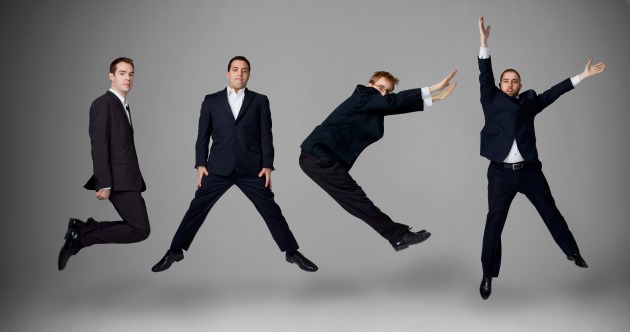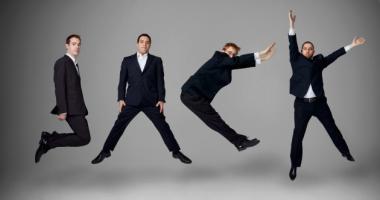
With the launch of PIVOT this month, San Francisco Performances becomes the latest in a slew of Bay Area arts organizations to initiate a hipper, more adventurous spinoff series. And, like San Francisco Symphony’s SoundBox and the S.F. Opera Lab, PIVOT bills itself as nontraditional and innovative.
But if these other organizations gravitate toward the high-tech (S.F. Opera will mount multimedia shows; SoundBox has Meyer Sound), PIVOT’s inaugural concert, on Friday, March 4, represented a return to the proverbial Dark Ages: the JACK Quartet performed Georg Friedrich Haas’s Quartet No. 3, “In iij. Noct.” in the pitch-black at the Strand Theater.
In the Roman Catholic Tenebrae services to which “In iij. Noct.” (2001) refers, candles are successively extinguished until the church is completely dark. But performers of Haas’s piece do not enjoy this luxury of initial light: The space is completely darkened as soon as they are situated, not onstage, but in the four corners of the room. The JACK Quartet — Christopher Otto and Ari Streisfeld, violins; John Pickford Richards, viola; and Kevin McFarland, cello — has performed the work more than 30 times. At some venues, audience members have had to sign waivers, while fire marshals have stood at the ready.
Instructing the audience members to put away their cellphones, digital watches, and anything else that could potentially glow, S.F. Performances Technical Director Patty-Ann Farrell conducted a brief “darkness test,” allowing patrons uncomfortable with the setup to leave before the piece began. After so much ceremony, I expected to feel apprehensive, sitting in utter darkness for an hour-long, improvisatory piece. Indeed, without visual cues, every sound became surprising: Straining to hear the percussive bow taps in the opening minutes of JACK’s performance, I anticipated with some trepidation the inevitable first explosion of sound.
But that first interjection — and all those after — felt not jarring, but joyous, because “In iij. Noct.” invites the audience to let go of all expectations and listen in new ways. Often, specific creaks and croaks were distinguishable as coming from a particular player, but other times, the texture grew blurry: A flautando gesture sounded like the cellist playing at the top of his register, but it came from a corner where I knew a violinist stood. I became less a specialist and more an awed bystander — along for the ride, with no choice but to simply embrace the sounds.
And there was a wealth of sounds: unfurling pizzicato lines, droning trills played sul ponticello, insistent tritones. Recurring chords tuned to the overtone series (with the deliciously low-to-our-ears sevenths and thirds) slid up and down, like stunningly beautiful sirens.
Haas, an Austrian composer, is often referred to as a spectralist, but when asked in 2013 about his formal and analytical considerations, he replied, “I trust my sensations ... I do not have any system. I do not trust systems at all.” For those who wish to better understand his methods, it’s a maddening response. Yet there’s no better way to describe “In iij. Noct.”: The sounds, more than anything else, simply work.
Of course, Haas’s piece was successful largely because of the high artistic caliber of the JACK Quartet. Streisfeld described the group’s initial experience of the piece as disorienting, but hearing the musicians on Friday — 30-odd performances later — it’s hard to imagine that they ever felt less than comfortable playing the work. Superlatives fail. In the busy and disjunct improvisatory passages, as much as in the quotations of 16th-century music, the group moved as one. Rarely do quartets achieve such a high level of communication.
Without knowing the specifics of the improvisatory system, the audience can’t understand why or how a gesture triggers a certain response, yet somehow, JACK seemed to start and end each episode at exactly the right time. This is a rare power: As a performing group, JACK makes the incomprehensible comprehensible, and audiences need not be knowledgeable about the music on the program in order to enjoy it.

